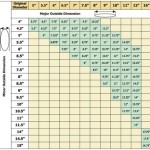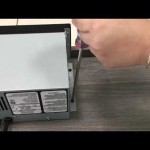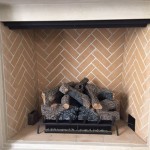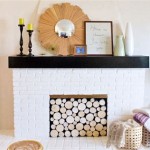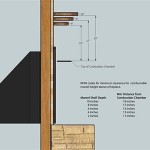Determining Optimal TV Over Fireplace Mantel Height
Mounting a television above a fireplace mantel is a popular aesthetic choice, combining entertainment and a focal point within a living space. However, improper placement can lead to discomfort, eye strain, and long-term health concerns. The optimal height for a television above a fireplace mantel is a crucial factor that requires careful consideration. This article explores the parameters that influence the ideal viewing height, analyzing factors such as viewing distance, television size, and individual preferences to provide a comprehensive understanding of the issue.
Placing a television too high forces viewers to tilt their heads upwards for extended periods. This unnatural posture can strain neck muscles, leading to pain, stiffness, and potentially chronic musculoskeletal problems. Conversely, a television positioned too low might not provide a clear line of sight, especially if furniture or other obstructions are present. Furthermore, the heat generated by the fireplace can damage the television over time, reducing its lifespan and performance. Therefore, striking a balance that prioritizes viewing comfort, safety, and aesthetic harmony is essential.
Key Point 1: Understanding the Ergonomics of Television Viewing
Ergonomics plays a significant role in determining the optimal television height. Viewing angle, distance, and screen size all contribute to a comfortable viewing experience. The generally accepted ergonomic principle suggests that the center of the television screen should be at or slightly below eye level when seated. This minimizes neck strain and allows for relaxed viewing over extended periods. To apply this principle to a television mounted above a fireplace, several measurements and calculations are necessary.
First, measure the distance from your typical seating position to the wall where the television will be mounted. This viewing distance is a critical factor in determining the appropriate screen size. Next, determine the height of your eye level when seated in your usual viewing spot. This is the baseline measurement against which the optimal television height will be calculated. The goal is to position the center of the screen as close as possible to this eye-level height when seated, while also accounting for the presence of the fireplace mantel.
The size of the television also influences the optimal mounting height. A larger screen necessitates a greater viewing distance to avoid a distorted or overwhelming viewing experience. Conversely, a smaller screen may not be visible from a greater distance. Online calculators and tables are available that correlate screen size with recommended viewing distances, providing a helpful starting point for determining the ideal television size for your specific room and seating arrangement. Ensuring the screen dimensions and viewing distance are optimized creates a foundation for determining the appropriate mounting height above the fireplace mantel.
Consideration should also be given to potential glare from windows or other light sources. Tilting the television slightly downwards can help reduce glare and improve visibility. However, excessive tilting can exacerbate neck strain. Anti-glare screens or strategically placed lighting can also mitigate glare issues without compromising viewing comfort. The angle of the television should be carefully adjusted to minimize reflections and ensure a clear and comfortable viewing experience from all seating positions.
Key Point 2: Assessing the Impact of the Fireplace and Mantel
The fireplace and mantel present both aesthetic and practical considerations when mounting a television above them. The mantel's height and depth significantly impact the available space and the potential for heat damage to the television. It is essential to measure the mantel's height accurately and factor it into the calculation of the overall television mounting height. A taller mantel necessitates a higher television placement, which may compromise ergonomic viewing principles. In such cases, alternative mounting solutions or fireplace modifications may be necessary.
Heat generated by the fireplace is a serious concern. Excessive heat can damage the television's internal components, leading to premature failure. The severity of the heat issue depends on the type of fireplace, the mantel's design, and the distance between the fireplace and the television. Gas fireplaces typically produce more consistent and manageable heat compared to wood-burning fireplaces. Wood-burning fireplaces can generate intense bursts of heat that can be particularly detrimental to the television.
A deeper mantel can provide a degree of protection from the heat rising from the fireplace. However, even with a deep mantel, it is crucial to monitor the temperature above the fireplace during operation. Installing a heat shield above the fireplace can deflect heat away from the television, providing an additional layer of protection. Ventilation is also critical. Ensuring adequate airflow around the television helps dissipate heat and prevent overheating.
If the heat produced by the fireplace is excessive or difficult to manage, alternative mounting solutions may be necessary. Consider mounting the television to the side of the fireplace or on a separate wall altogether. This eliminates the risk of heat damage and allows for more flexible placement options that prioritize ergonomic viewing comfort. While mounting the television above the fireplace may be aesthetically appealing, prioritizing the longevity and performance of the television is essential.
Key Point 3: Implementing Practical Solutions and Alternative Options
Once the ergonomic and fireplace-related factors have been assessed, implementing practical solutions to achieve the optimal television height is crucial. Adjustable television mounts offer flexibility in adjusting the screen's height and angle, allowing for fine-tuning to achieve the most comfortable viewing position. These mounts typically allow for tilting and swiveling, enabling viewers to customize the screen's orientation based on their seating position and lighting conditions.
If the mantel is too high or the fireplace produces excessive heat, consider modifying the mantel's design. Lowering the mantel or installing a heat shield can create more space and protect the television from heat damage. Consulting with a fireplace specialist or contractor can provide valuable insights and recommendations for fireplace modifications that address both aesthetic and functional concerns. It is important to ensure that any modifications comply with local building codes and safety regulations.
Alternative mounting options include wall-mounted televisions to the side of the fireplace or on a separate wall. This provides greater flexibility in positioning the television at the optimal height and eliminates the risk of heat damage. Floating shelves or cabinets can be installed below the television to provide storage space and create a cohesive aesthetic. When choosing a wall mount, ensure it is compatible with the television's weight and VESA mounting pattern. A secure and properly installed wall mount is essential for preventing accidents and ensuring the television's stability.
Another option is to conceal the television when it is not in use. Motorized television lifts or cabinets can hide the television behind artwork or within a piece of furniture, maintaining a clean and uncluttered aesthetic. These solutions can be particularly appealing in spaces where the homeowner prefers to minimize the visual impact of the television when it is not being watched. However, these solutions can be more expensive and require careful planning and installation.
Ultimately, determining the optimal television height above a fireplace mantel requires a careful analysis of ergonomic principles, fireplace considerations, and practical solutions. By understanding the factors that contribute to comfortable viewing and mitigating the risks associated with fireplace heat, homeowners can create a functional and aesthetically pleasing entertainment space that prioritizes both visual enjoyment and long-term well-being. Consulting with professionals, such as interior designers, audio-visual specialists, and fireplace contractors, can provide valuable guidance and ensure that the television is mounted safely and effectively.

Can I Mount A Tv Over My Fireplace Warming Trends

Can You Put An Electric Fireplace Under A Tv And Minimum Distance
Is A Tv Over Fireplace Too High Quora

Can I Mount A Tv Over My Fireplace Forshaw Of St Louis

Arranging A Fireplace And Television Fine Homebuilding

Mantel Height For Linear Fireplace Google Search Gas Ledge Decor

What Size Samsung Frame Tv Over Your Fireplace Chrissy Marie Blog

Modern Mantel Decor With A Tv 7 Ways To Pull It Off Chrissy Marie Blog

Mantel Decorating With A Tv Brepurposed

Pros And Cons Debate Putting Your Tv Over The Fireplace
Related Posts

